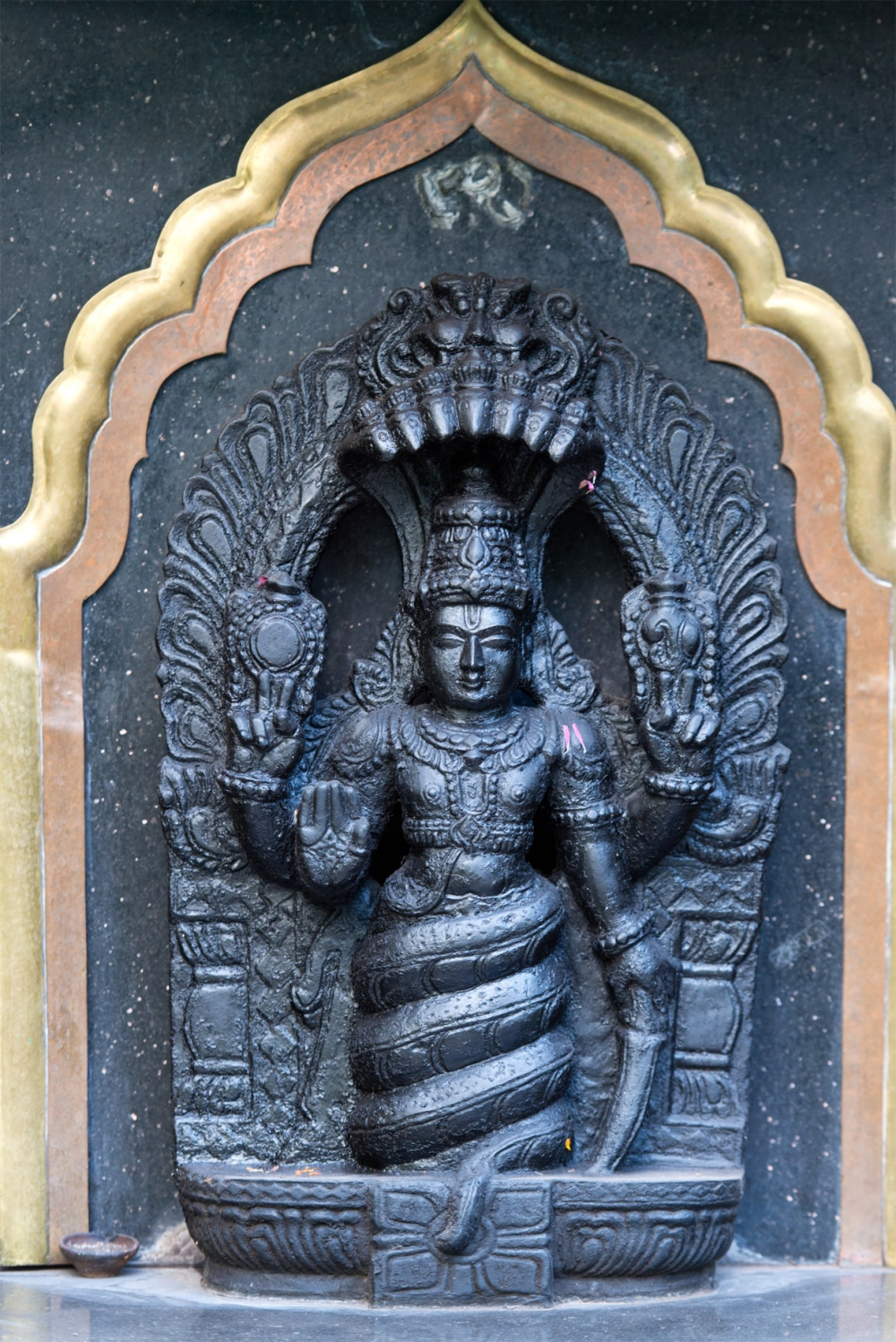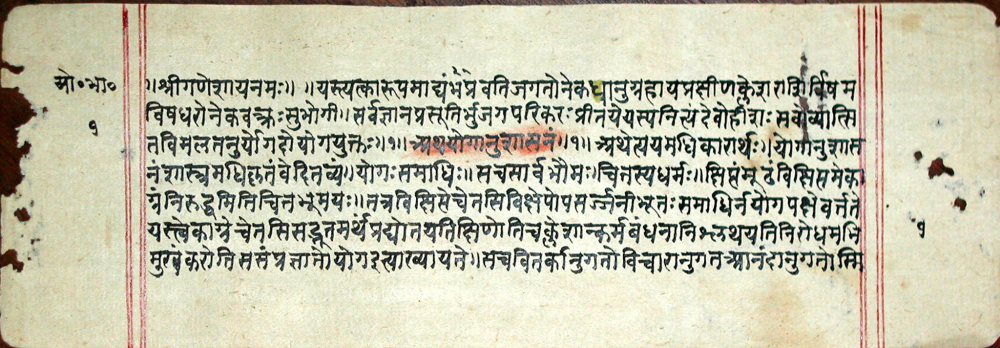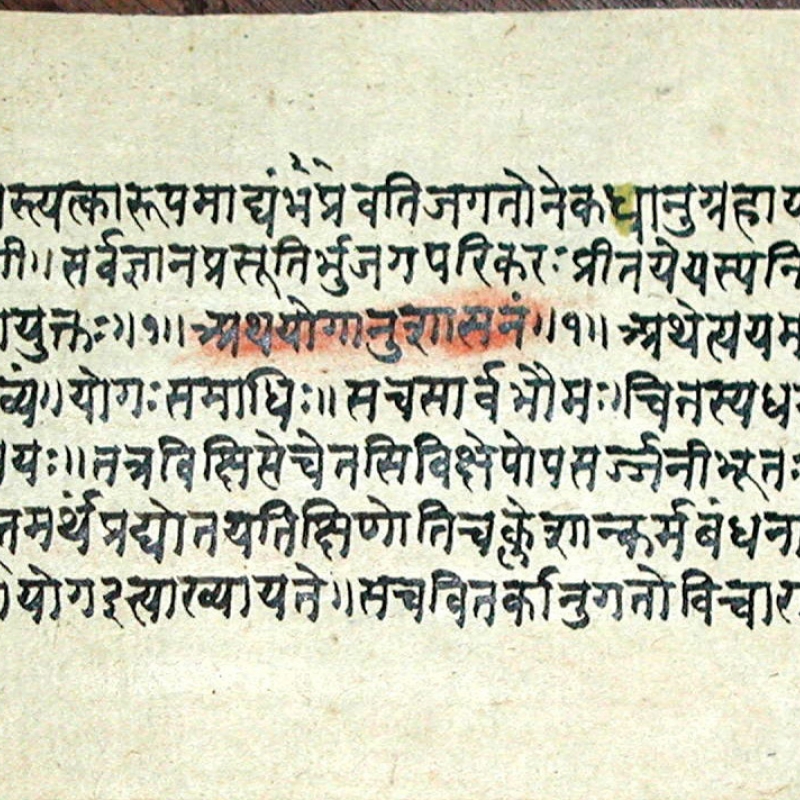General Introduction[1]
The late fourth or early fifth century Pātañjalayogaśāstra is the oldest preserved systematic Sanskrit exposition from a Brāhmaṇa milieu on spiritual liberation through meditation. It is divided into four chapters or quarters (pāda), each consisting of two frequently clearly distinguishable layers of text, i.e., of ca. 195 brief nominal phrases, the yogasūtras, and elaborations thereon. The text supplementing the yogasūtras is frequently depicted in secondary literature as a commentary on the Yogasūtra called Yogabhāṣya and attributed to the mythical figure Vyāsa or Veda-Vyāsa.[2]
The Pātañjalayogaśāstra was probably partly composed and partly compiled by an author-redactor named Patañjali, about whom nothing specific is known. This lack of historical information was compensated by hagiography and mythology. Prior to the beginning of the eleventh century, the yoga author Patañjali was identified with the Sanskrit grammarian of the same name who had composed his Mahābhāṣya in 150 BCE, and with the author of a foundational work of Āyurveda, the Carakasaṃhitā, who probably lived in the first century CE.[3] Tradition not only fused three historically distinct authors into a single personality, it also furnished this virtual author with a divine status when it turned Patañjali into an incarnation (avatāra) of the divine serpent Śeṣa or Ananta. The earliest textual evidence for this identification is a Bengali work on grammar, composed after the beginning of the twelfth century.[4]

Irrespective of whether or not the Pātañjalayogaśāstra is the work of a single author-redactor, the explanations of the so-called Yogabhāṣya are indispensable for any appropriate interpretation of the frequently enigmatic sūtras in their contemporary religious, philosophical and cultural contexts.[5]
Religio-philosophical Foundations[6]
Patañjali’s philosophy is based on the premise that the world consists of two ontologically different realms. On the one side, there exist innumerable transcendental Subjects or Selves. The Subjects are entities of pure consciousness, free of any content. They lack activity, are permanent and unchangeable. On the other side, the world consists of the products of primordial or proto-matter, which is unconscious, active and changeable. Under the attraction of the Subjects, proto-matter transforms from an unspecified state, which lies beyond human comprehension, into the things of the perceptible world and into individual living beings with mental capacities. This process of transformation is conceived of as a progressive increase of attributes on a permanent but changeable substance consisting of the three constituents or forces (guṇa) called sattva, rajas, and tamas, which inter alia leads to the formation of the mental organ (citta) of living beings.
The existence of each mental organ is not limited to a single existence. As a store of mental impressions, caused by actions with karmic relevance, mental capacities exist from primordial time and potentially for ever, as long as they do not dissolve in final liberation.
The mental organ provides the Subject with data that turn into contents of consciousness when the Subject perceives them. Perceptions of contents leave impressions in the mental organ that can be reactivated as memories. Concerning the yogic conceptions of karma and rebirth, impressions originating in connection with karmic-relevant actions are of special significance. Their storage determines the quality of any rebirth.
In everyday experience, however, mental processes usually appear as being of a unitary nature, which, according to Patañjali, is a fundamental error. The Subject is normally deluded about its own transcendental nature and thus deems itself affected by mental contents although these in reality exclusively affect the mental organ.
The aim of human existence, according to Patañjali, is to terminate the erroneous identification of the Subject with the mental organ, which leads to spiritual liberation during the present life of the yogi.
Structure and Contents
The Pātañjalayogaśāstra consists of four chapters or ‘quarters’ (pāda), each bearing a specific chapter title.[7] The initial quarter, ‘on absorption’ (samādhipāda), consists of 51 brief sections of sūtra-text together with an accompanying bhāṣya-part.[8] It opens with four sections introducing the topic ‘yoga’ and defining the aim of yoga from a psychological perspective as the cessation of mental activity leading to the continuous existence of the Subject in its own form or nature (svarūpa). The following seven sections (5–11) treat the five categories of mental activities. Next, Patañjali discusses the two general means towards liberation, i.e., repeated practice (abhyāsa) and detachment (vairāgya) (12–16), before he sketches a specific form of meditation, the non-theistic yogic concentration that focuses on the Subject of the yogi (17–20).[9] Following a brief excursion on different types of yogis (21–22), Patañjali turns to the theistic yogic concentration (23–29).[10] This meditation focuses on God, who is conceived of as a prototype of an eternally liberated Subject. In concluding this passage, Patañjali stresses the specific usefulness of this meditation for overcoming spiritual hindrances and their side effects, which he then depicts together with additional methods for their prevention (30–32). Next, Patañjali turns to methods of establishing an initial stability of the mind (33–40) that are required for a more advanced form of meditation called samāpatti. (41–51).[11]

The second quarter, consisting of 55 sections, is called ‘instruction in means’ (sādhananirdeśa). It initially presents a specific form of yoga practice called kriyāyoga that involves asceticism, mantra repetition and devotion to God (1–2) in order to support meditative absorption and to weaken the afflictions, which are treated next (3–9) together with different means for their elimination (10–11). Then Patañjali presents the mechanism of karmic retribution (12–14). This topic leads to a discussion of the question why yogis, in contradistinction to ordinary people, experience suffering as a universal phenomenon that is intrinsic even to seemingly joyful experiences (15–16). In this context, Patañjali presents a fourfold division of the science of yoga (in analogy to that of medicine) into (a) what has to be avoided, (b) the cause of what has to be avoided, (c) avoiding and (d) the means for avoiding. This division, which structures larger parts of the remaining work, is probably based on the four noble truths of Buddhism.[12] The cause of what has to be avoided, i.e., the cause of suffering, is discussed in sections 17–24. Patañjali addresses the topic of how to avoid suffering (25), before he turns to the means for avoiding, i.e., to the eight ancillaries or means of yoga (aṣṭāṅga), comprising commitments, obligations, posture, breath control, retraction of the senses, fixation, meditation and absorption.[13] The first two means, i.e., the five commitments and five religious obligations together with supernatural powers and knowledge arising from complying with these regulations, are the topic of sections 26–45. The final part of the second quarter is devoted to posture practice (46–48),[14] breath control (49–53) and to the retraction of the senses from their everyday objects (54–55).
The third quarter, called ‘on supernatural powers’ (vibhūtipāda), continues the presentation of means towards liberation by characterising the three meditation-related means, i.e., fixation, meditation and absorption (1–3).[15] Patañjali refers to this triplet with the technical term ‘complete control’ (saṃyama) when directed on an identical object (4–10). The discussion of the mental organ in its various stages leads Patañjali to an excursion on the Sāṅkhya-Yoga doctrine of the threefold transformation of properties, time characteristics and states (11–15). The following sections present the topic to which the third quarter owes its title, namely supernatural powers and knowledge arising in consequence of yogic meditation on different objects. In his conclusion of this quarter, Patañjali emphasises that liberating insight into the difference between matter and mind is supreme among all forms of power and knowledge reachable by yogic meditation (16–55).
The fourth and final quarter, with the title ‘on separation’ (kaivalyapāda), initially addresses a number of loosely-related topics, such as different causes for supernatural powers and forms of knowledge (1) and the role of accumulated karma for the generation of a body in the process of rebirth (2–3). This leads Patañjali to deal with the question of how several bodies that advanced yogis may miraculously create are related to their own mental organs and to the mental organs of their creator (4–5). Subsequently, Patañjali discusses the consequences and actions of the miraculously created beings have in terms of karmic retribution (6). Then he introduces a quadruple conception of karma. Three kinds of karma exist for virtually all beings, who inevitably experience its maturation, whereas the fourth kind of karma, which does not bring about consequences, is peculiar to advanced yogis. Karma in general is accumulated when mental activity takes place, which generates mental impresses (vāsanā). These impresses can be eliminated through a removal of the factors leading to their generation and storage in the mental organ (7–11). In the following part of his work, Patañjali addresses polemic objections against his system of thought from rival philosophical schools including that of Vijñānavāda-Buddhism (12–24). After having thus established the coherence of his work, he turns to a final exposition of spiritual liberation by means of special meditative insight into the difference of mind-matter and the conscious Subject (25–34).
Dating
Patañjali’s date can be established to a short time span around the year 400 CE. References to Vijñānavāda-Buddhism in Pātañjalayogaśāstra 4.16 indicate Patañjali’s familiarity with the works of the Buddhist philosopher Vasubandhu, who lived between 320 and 400 CE.[16] The latest possible date is established on the basis of a quotation from Pātañjalayogaśāstra 2.6 in the oldest commentary (vṛtti) on Bhartṛhari’s Vākyapadīya 2.31. Bhartṛhari flourished probably between the years 450 and 510 CE. The vṛtti, whose authorship is contested, was probably composed during the same time, possibly by one of Bhartṛhari’s students. Accordingly, the Pātañjalayogaśāstra must have been known in the second half of the fifth century as an authoritative work within the circles of Śabdādvaita philosophy. If one assumes some time to pass before a newly composed work acquires the prestige that makes it worthy of being quoted and discussed in the work of a rival school of philosophy, the Pātañjalayogaśāstra must have been composed around the year 400 CE. This dating is supported by the fact that Patañjali’s work is quoted in the Nyāyabhāṣya, which Vātsyāyana composed probably around the year 450 CE.[17]
Commentaries
From possibly the eighth century onwards, the Pātañjalayogaśāstra became the subject of extensive commentaries. The probably oldest preserved but definitely most informative one is the Pātañjalayogaśāstravivaraṇa by an author called Śaṅkara.[18] The question of whether this Śaṅkara is identical with the famous Advaitavedānta philosopher of the same name is still unsolved.[19] A further important commentary was composed by the famous polymath Vācaspatimiśra I, ca. 950 CE, who, however, apparently was frequently unable to provide first-hand explanations of a text from an ascetic milieu that was alien to him and written in an idiom permeated with Buddhist terminology.[20]
King Bhoja of Mālava employed an innovative strategy for dealing with the difficult idiom of the Pātañjalayogaśāstra when he composed a commentary called Rājamartaṇḍa exclusively on the sūtra-part at the beginning of the eleventh century. Bhoja extracted the sūtras from the Pātañjalayogaśāstra and provided them with a paraphrase of the bhāṣya-part of Patañjali’s work that he supplemented with his own explanations.
Vijñānabhikṣu composed a further commentary, this time from the perspective of Bhedābhedavedānta, in the latter half of the sixteenth century called Yogavārttika. This commentary is, however, frequently indebted to Vācaspatimiśra’s Tattvavaiśāradī.[21] Further Sanskrit commentaries on the Yogasūtras were composed throughout the Middle Ages and in modern times.[22]
Notes
[1] Section 1 of this article is an extended and revised version of Maas, ‘Sthirasukham Āsanam,’ 52f.
[2] On the problem of the authorship of the sūtra- and the bhāṣya-part of the Pātañjalayogaśāstra, see Maas, ‘A Concise Historiography of Classical Yoga Philosophy,’ 57–67.
[3] See Maas, ‘A Concise Historiography of Classical Yoga Philosophy,’ 66.
[4] See Maas, ‘“Descent with Modification”,’ 113.
[5] See Maas, ‘A Concise Historiography of Classical Yoga Philosophy,’ 68.
[6] Section 2 is a slightly revised English translation of Maas, ‘Der Yogi und sein Heilsweg im Yoga des Patañjali,’ 67f.
[7] See Maas, ‘Samādhipāda,’ xx–xxi.
[8] Sūtra 1.6 lacks an accompanying bhāṣya section.
[9] See Oberhammer, ‘Strukturen yogischer Meditation,’ 135–161 and Maas, ‘The So-called Yoga of Suppression in the Pātañjala Yogaśāstra,’ 264–276.
[10] See Oberhammer, ‘Strukturen yogischer Meditation,’ 162–177 and Maas, ‘The So-called Yoga of Suppression in the Pātañjala Yogaśāstra,’ 276–280.
[11] See Oberhammer, ‘Strukturen yogischer Meditation,’ 177–209.
[12] See Wezler, ‘On the Quadruple Division of the Yogaśāstra,’ 336.
[13] See Birch, ‘The Yamas and Niyamas,’ and Mallinson and Singleton, ‘Roots of Yoga.’
[14] See Maas, ‘Sthirasukham Āsanam.’
[15] On the phenomenon of supernatural powers in yoga, see Jacobsen, ‘Yoga Powers.’
[16] Franco and Preisendanz, ‘Vorwort,’ xvi.
[17] Quotations from the Pātañjalayogaśāstra in the Nyāyabhāṣya occur at Nyāyabhāṣya 1.2.6 and 3.2.15. See Thakur, ‘Gautamīyanyāyadarśana,’ x. For the date of the Nyāyabhāṣya, see Franco and Preisendanz, ‘Bhavadāsa’s Interpretation of Mīmāṃsāsūtra.’
[18] Rama Sastri and Krishnamurthi Sastri, ‘Pātañjala-Yogasūtra-Bhāṣya-Vivaraṇa of Śaṅkara-Bhagavatpāda.’ Transl. in Legget, ‘The Complete Commentary by Śaṅkara on the Yoga Sūtra-s.’ First chapter crit. ed in Harimoto, ‘Critical Edition of the Pātañjalayogaśāstravivaraṇa.’
[19] See Maas, ‘A Concise Historiography of Classical Yoga Philosophy,’ 72–75.
[20] Ed. in Āgāśe, ‘VācaspatimiśraviracitaṭīkāsaṃvalitaVyāsabhāṣyasametāni.’ The most reliable translation is still that of Woods, ‘The Yoga-System of Patañjali.’
[21] Ed. and transl. in Rukmani, ‘Yogavārttika of Vijñānabhikṣu.’
[22] See Larson and Bhattacharya, ‘Yoga,’ 321–433.
Bibliography
Āgāśe, K.Ś., ed. VācaspatimiśraviracitaṭīkāsaṃvalitaVyāsabhāṣyasametāni Pātañjalayogasūtrāṇi tathā BhojadevaviracitaRājamārtaṇḍābhidhavṛttisametāni Pātañjalayogasūtrāṇi. Puṇyākhyapattana: Ānandāśramamudraṇālaya, 1904. Accessed October 25, 2019. https://archive.org/details/yogasutra_and_vyasa_bhasya_and_vacaspati_1904
Birch, J. ‘The Yamas and Niyamas: Part 1 – Patañjali’s View.’ Yoga Scotland Magazine 49 (2016): 32–35. Accessed October 25, 2019. https://www.academia.edu/19940340/The_Yamas_and_Niyamas_Part_1_-_Pata%C3%B1jalis_View
Franco, E. and K. Preisendanz. ‘Bhavadāsa’s Interpretation of Mīmāṃsāsūtra 1.1.4 and the Date of the Nyāyabhāṣya.’ Berliner Indologische Studien 8 (1995): 81–86.
Franco, E. and K. Preisendanz. ‘Vorwort.’ In Die Philosophie des Buddhismus, Erich Frauwallner, 5. Aufl. Berlin: Akademie Verlag, 2010, XI–XXX.
Harimoto, K. A Critical Edition of the Pātañjalayogaśāstravivaraṇa. First Part: Samādhipāda with an Introduction. PhD Thesis in Asian and Middle Eastern Studies. University of Pennsylvania, Philadelphia, 1999. Accessed October 25, 2019. https://www.academia.edu/21019097/A_critical_edition_of_the_Patanjalayogasastravivarana_First_Pada_Samadhipada_with_an_introduction
Jacobsen, K.A., ed. Yoga Powers. Extraordinary Capacities Attained Through Meditation and Concentration. Leiden, Boston: Brill, 2012.
Larson, G.J. and R.S. Bhattacharya. Yoga. India’s Philosophy of Meditation. Delhi: Motilal Banarsidass (Encyclopedia of Indian Philosophies 12), 2008.
Leggett, T. The Complete Commentary by Śaṅkara on the Yoga Sūtra-s: A Full Translation of the Newly Discovered Text. London: Kegan Paul, 1990.
Maas, Ph. A. Samādhipāda. Das erste Kapitel des Pātañjalayogaśāstra zum ersten Mal kritisch ediert. Aachen: Shaker, 2006.
Maas, Ph.A. ‘“Descent with Modification”: The Opening of the Pātañjalayogaśāstra.’ In Śāstrārambha. Inquiries into the Preamble in Sanskrit, edited by W. Slaje, Wiesbaden: Harrassowitz, 2008, 97–119. Accessed October 25, 2019. https://www.academia.edu/234338/_Descent_with_Modification_The_Opening_of_the_ Pātañjalayogaśāstra
Maas, Ph. A. ‘The So-called Yoga of Suppression in the Pātañjala Yogaśāstra.’ In Yogic Perception, Meditation, and Altered States of Consciousness, edited by E. Franco in collaboration with D. Eigner. Vienna: Verlag der Österreichischen Akademie der Wissenschaften, 2009: 263–282. Accessed October 25, 2019. https://www.academia.edu/210373/The_So-called_Yoga_of_Suppression_in_the_ Pātañjalayogaśāstra
Maas, Ph. A. ‘A Concise Historiography of Classical Yoga Philosophy.’ In Periodization and Historiography of Indian Philosophy edited by E. Franco. Vienna: Sammlung de Nobili, 2013: 53–90. Accessed October 25, 2019. https://www.academia.edu/3520571/A_Concise_Historiography_of_Classical_Yoga_Philosophy
Maas, Ph. A. ‘Der Yogi und sein Heilsweg im Yoga des Patañjali.’ In Wege zum Heil(igen)? Sakralität und Sakralisierung in hinduistischen Traditionen, edited by K. Steiner. Wiesbaden: Harrassowitz, 2014: 65–89. Accessed October 25, 2019. https://www.academia.edu/7054657/Der_Yogi_und_sein_Heilsweg_im_Yoga_des_ Pātañjali
Maas, Ph. A. ‘Sthirasukham Āsanam: Posture and Performance in Classical Yoga and Beyond.’ In Yoga in Transformation. Historical and Contemporary Perspectives, edited by K. Baier, Ph. A. Maas and K. Preisendanz. Vienna: Vienna University Press, 2018: 49–100. Accessed October 25, 2019. https://doi.org/10.14220/9783737008624.49
Mallinson, J. and M. Singleton. Roots of Yoga. Translated and Edited with an Introduction. London: Penguin Random House, 2017.
Oberhammer, G. Strukturen yogischer Meditation. Untersuchungen zur Spiritualität des Yoga. Wien: Österreichische Akademie der Wissenschaften, 1977. Accessed October 25, 2019. https://archive.org/details/Oberhammer1977StrukturenYogischerMeditation.UntersuchungenZurSpiritualittDesYoga
Pātañjalayogaśāśtra. See Maas 2006 (for the initial quarter) and Āgāśe 1904 (for quarters 2–4).
Rama Sastri, P.S. and S.R. Krishnamurthi Sastri, eds. Pātañjala-Yogasūtra-Bhāṣya-Vivaraṇa of Śaṅkara-Bhagavatpāda. Madras: Government Oriental Manuscript Library, 1952. Accessed October 25, 2019. https://archive.org/details/Patanjala-yogasutra-bhasyaVivaranamOfSankara-bhagavatpada
Rukmani, T.S. Yogavārttika of Vijñānabhikṣu. Text with English Translation of the Pātañjala Yogasūtra and Vyāsabhāṣya. Vols. 1–4: New Delhi: Munshiram Manoharlal, 1981–1989.
Thakur, A., ed. Gautamīyanyāyadarśana. With Bhāṣya of Vātsyāyana. New Delhi: Indian Council of Philosophical Research, 1997.
Wezler, A. ‘On the Quadruple Division of the Yogaśāstra, the Caturvyūhatva of the Cikitsāśāstra and the ‘Four Noble Truths’ of the Buddha (Studies in the Pātañjalayogaśāstravivaraṇa 2).’ Indologica Taurinensia 12 (1984): 289–337. Accessed October 25, 2019. http://www.asiainstitutetorino.it/Indologica/volumes/vol12/vol12_art20_WEZLER.pdf
Woods, J.H. The Yoga-System of Patañjali, Or the Ancient Hindu Doctrine of Concentration of Mind, Embracing the Mnemonic Rules, Called Yoga-Sūtras, of Patañjali and the Comment, Called Yoga-Bhāshya, Attributed to Veda-Vyāsa, and the Explanation, Called Tattva-Vaiçāradī, of Vāchaspati-Miçra. Cambridge: Harvard University Press, 1914 (repr. Delhi: Motilal Banarsidass, 1992). Accessed October 25, 2019. https://archive.org/details/in.ernet.dli.2015.40668













